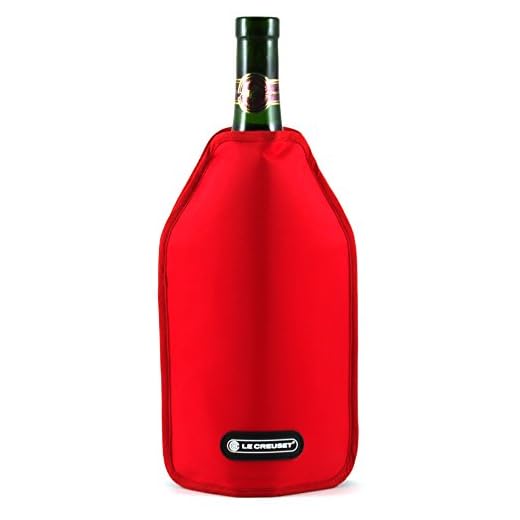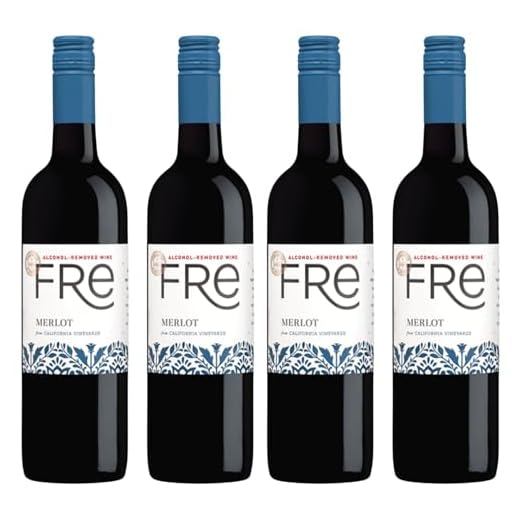



Serving chilled varieties between 45°F to 50°F (7°C to 10°C) enhances refreshing characteristics and aromatic profiles, making them perfect for warm-weather enjoyment. This level of coolness allows the delicate notes to shine, providing a crisp and invigorating experience on the palate.
In contrast, heartier selections are best enjoyed at slightly higher temperatures, typically between 55°F to 65°F (13°C to 18°C). This warmth promotes the rich flavors and complexities, allowing the nuances of oak and fruit to develop fully. A well-structured pour can reveal layers of taste that are often muted when served too cold.
Understanding these temperature guidelines not only elevates the tasting experience but also showcases the unique qualities of each pour. Experimenting with different temperatures can lead to delightful discoveries, enriching the overall appreciation of each bottle opened.
Do You Chill White Wine or Red Wine
Opt for a temperature of 45-50°F for the chilled variety, enhancing its refreshing qualities. For the other type, a serving temperature around 55-65°F allows for the full expression of its complex flavors and aromas. This approach ensures that the nuances are well appreciated, allowing the tasting experience to be truly enjoyable.
Consider the occasion and the dish being served. A lighter, crisper choice pairs well with seafood or salads, while the bolder option complements red meats or hearty dishes. Remember that serving at the correct temperature can significantly impact the overall tasting experience.
Using a wine thermometer can help achieve the desired temperature accurately. If a quick adjustment is needed, an ice bucket for the lighter variety or a short time in the fridge for the bolder option can work wonders. Balancing temperature with food pairings is key to elevating the overall meal experience.
Understanding the Ideal Serving Temperature for White Wine
Serving temperature for chilled varietals typically ranges from 45°F to 55°F (7°C to 13°C). For optimal enjoyment, a range of 50°F to 55°F (10°C to 13°C) is recommended, especially for more complex styles.
Light and crisp selections, such as Sauvignon Blanc or Pinot Grigio, benefit from a cooler temperature closer to 45°F (7°C). This enhances their refreshing acidity and bright fruit notes.
Full-bodied options, like Chardonnay or Viognier, are best served slightly warmer, around 50°F to 55°F (10°C to 13°C). This temperature allows the richer flavors and aromas to fully express themselves, providing a more rounded tasting experience.
For serving, consider using an ice bucket filled with water and ice. This method maintains consistent temperature without risking over-chilling, which can mute flavors. A quick chilling in the freezer for 20-30 minutes can also be effective if time is limited.
Temperature can significantly alter perception. Too cold can mask subtle aromas, while too warm may amplify undesirable characteristics. Always aim for balance to enhance the overall tasting experience.
When to Chill Red Wine: Myths and Facts
Serving temperature plays a significant role in the tasting experience of various beverages. For many, it is a common misconception that reds should always be served at room temperature. In reality, a slight cooling can enhance the flavors and aromas of many varietals, particularly those with higher tannin levels.
Generally, a temperature range of 55°F to 65°F (13°C to 18°C) is recommended for most dark varietals. A slightly lower temperature can help soften the perception of tannins, making the experience smoother and more enjoyable. For example, a Cabernet Sauvignon or a Syrah can benefit from being slightly cooled to around 60°F (15°C) before serving.
Another myth is that light-bodied options, such as Pinot Noir, must follow the same rules as their fuller-bodied counterparts. In fact, serving a lighter varietal closer to 55°F (13°C) can elevate its delicate fruit notes and enhance its overall complexity. This approach allows for a refreshing profile that complements many dishes.
It’s essential to consider the climate and setting as well. In warmer regions or during summer months, a touch of cooling can make these beverages more palatable. Experimenting with temperatures can reveal hidden nuances, creating a more delightful experience.
In conclusion, understanding the ideal serving temperatures for various types of dark varietals can significantly enhance the tasting experience, transforming how flavors are perceived and enjoyed. Adjusting the temperature can unlock new dimensions, making each sip a revelation.
Best Practices for Chilling White Wine at Home
For optimal enjoyment, maintain a serving temperature of 45-50°F (7-10°C) for chilled beverages. Here are some methods to achieve this:
1. Ice Water Bath
- Fill a bucket with equal parts ice and water.
- Submerge the bottle for about 15-20 minutes.
- This method rapidly cools, ensuring an even temperature.
2. Refrigerator Method
- Place the bottle in the refrigerator for 3-4 hours before serving.
- Wrap the bottle in a damp cloth for enhanced cooling.
3. Quick Chill Techniques
- Use a specialized rapid chiller for immediate results.
- Wrap the bottle in aluminum foil and place it in the freezer for 20-30 minutes.
For optimal flavors, avoid over-chilling; doing so can mute the delicate notes of many varietals. If planning to pair with a meal, consider the dish’s temperature and flavors. For example, a seafood dish complements a chilled beverage well. Lastly, ensure to keep the bottle on ice during serving to maintain the ideal temperature.
For additional tips on timing, check out this guide on how long does it take to cook jasmine rice.
Methods to Properly Chill Red Wine
Start by utilizing an ice bath for optimal results. Fill a bucket halfway with ice and add water until it reaches the ice level. Immerse the bottle for about 15-20 minutes. This method ensures even cooling throughout the bottle without risking temperature fluctuations.
Alternatively, a refrigerator can be employed, but timing is key. A cooling period of 30-45 minutes is generally recommended. Place the bottle upright to minimize contact with the warmer air in the fridge, allowing for gradual temperature adjustment.
Quick Methods for Immediate Cooling
If immediate serving is required, consider wrapping the bottle in a damp cloth or paper towel. This technique can reduce the temperature in approximately 10-15 minutes. The moisture promotes faster cooling due to evaporation.
| Method | Time Required | Notes |
|---|---|---|
| Ice Bath | 15-20 minutes | Most effective for rapid cooling |
| Refrigerator | 30-45 minutes | Best for gradual cooling |
| Damp Towel | 10-15 minutes | Quick fix for urgent needs |
Avoiding Overcooling
Monitoring temperature is key. Aim for a range of 55°F to 65°F for optimal enjoyment. Overcooling can mask flavors, dull aromas, and inhibit the overall experience. Always check the wine’s characteristics before serving to ensure the best presentation.
Impact of Temperature on Wine Flavor Profiles
Serving beverages at the correct temperature significantly influences their aroma and taste. For instance, a crisp, chilled beverage may reveal bright citrus notes, while a warmer counterpart can bring out deeper, more complex flavors like stone fruit or earthy undertones. Optimal temperatures enhance fruit expression and acidity, creating a balanced experience.
For whites, aim for a range of 45-55°F (7-13°C). At this temperature, floral and fruity characteristics are pronounced, allowing subtleties to shine. If served too cold, those delicate aromas can become muted. Conversely, beverages served above 60°F (16°C) can lose their refreshing qualities and become overly heavy.
Reds benefit from a slightly higher serving range, typically around 55-65°F (13-18°C). At these levels, tannins soften, and fruit flavors become more pronounced. Serving at temperatures above 70°F (21°C) can lead to an overly alcoholic sensation, overshadowing the wine’s intricacies.
Experimenting with temperature can lead to delightful discoveries. A simple adjustment can transform the perception of a familiar bottle, revealing hidden layers and nuances. Always consider using a thermometer to ensure precision, as it can elevate the tasting experience significantly.
In the end, understanding the science behind temperature and its impact on flavor profiles can enhance enjoyment and appreciation. This knowledge empowers one to make informed choices, whether at home or in a tasting setting. Embrace the journey of discovery, where slight variations in temperature lead to extraordinary flavor revelations.
How to Choose the Right Wine for Chilling
Selecting the appropriate beverage for cooling relies on grape variety and regional characteristics. Here are some guidelines to assist in that choice.
Grapes and Their Profiles
- Fruity and aromatic varieties, such as Sauvignon Blanc and Riesling, thrive at lower temperatures, enhancing their refreshing qualities.
- Full-bodied options like Chardonnay or Viognier can benefit from slightly warmer temperatures to reveal their complex flavors.
- For reds, lighter styles such as Pinot Noir or Gamay show best when served cooler, which accentuates their fruity notes.
- Heavier varietals like Cabernet Sauvignon or Syrah require a more moderate temperature to maintain their structure and richness.
Regional Influences
- Consider the climate of the origin. Wines from warmer regions often have higher alcohol content and can taste better at slightly warmer serving temperatures.
- Cool-climate varietals typically pair well with lower temperatures, as their acidity remains vibrant, enhancing the taste experience.
Ultimately, understanding the characteristics of specific grape varieties and their origins allows for a more informed decision when selecting the right beverage for cooling. Adjusting temperatures based on these factors will lead to a more enjoyable tasting experience.
Tips for Serving Wine at Optimal Temperatures
Serving temperatures significantly influence the enjoyment of a beverage. For optimal experience, maintain these guidelines: fine varietals typically thrive at 45-55°F (7-13°C), while robust selections generally flourish at 55-65°F (13-18°C).
Use an accurate thermometer to gauge temperature precisely. A quick check ensures that the chosen bottle is at its best. For whites, aim for a cooler end of the spectrum, while fuller-bodied options can be slightly warmer.
Pre-cooling in the refrigerator for about 2-3 hours before serving will enhance freshness. Alternatively, an ice bucket filled with water and ice can achieve ideal temperatures in 20-30 minutes.
For heavier varieties, avoid over-chilling, as it can mask flavors. Let them breathe at room temperature for 10-15 minutes after removal from the cooler. This allows aromas to develop fully.
Temperature fluctuations can alter taste perception. Keep the environment stable; avoid direct sunlight and excessive heat. Serving in insulated glasses can help maintain the desired temperature longer.
Experiment with different varietals at various temperatures to discover personal preferences. Each varietal has its own optimal serving range, and exposure to varying conditions can enhance appreciation.








